With the deluge, and blown out rivers over this Christmas period, I have spent a bit of time at the vice, stocking my fly boxes. I was after a few rows of dry flies, since my box was starting to get down to just 2 or 3 specimens of any particular pattern. If you are like me, you have gone down the row and chosen the best ones, which you have since lost, and now it feels like you are using the dregs.
So with small dries in mind, I set about choosing hooks, tails, and thread.
Thread. Let me start with that. I have a few spools of Semperfli Nano silk in 12/0. I also have a spool of 24/0 and I am pretty sure I had something in between..18/0 or something. But on the dry flies I was tying, from #14 to #20, I found the 12/0 more than adequate. Quite honestly, I think it is fantastic! I would imagine some people will say it is too slippery, its tough on your scissors, and it cuts materials. All that would be true, but the stuff is so thin, and builds so little bulk, and is so strong, that I was determined to find ways around those apparent problems.
Firstly, once you have unwound it a bit, it lays incredibly flat and broad, and I found this made the difference between cutting deer hairs and not cutting them. Problem solved.
Then on the slippery part. Yes, it is remarkably slippery. You can tie in a tail with 8 winds of thread and still move it to adjust its position! My solutions to that are several. Firstly I used suplerglue…just a sliver on the end of a needle, here and there, to secure things. I also used wax on it, which solved the problem beautifully.
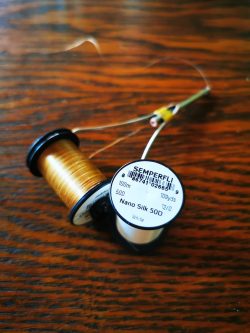
The other thing I did was to double materials over before tying them off, to anchor them, and prevent a Trout’s tooth from pulling a ribbing for example. These steps may be thought a hassle, but on balance I felt they were worthwhile.
I also did not feel the need to go any thinner than the 12/0 thread, even on the tiny dries…this stuff really doesn’t add bulk at all. In fact when tying some nymphs and trying to build some bulk into the taper, I found myself doing a lot of wrapping and not really getting there!
Cutting the stuff: I found myself snipping and hacking and leaving frayed ends, unable to achieve a clean cut….until I solved the riddle. Open your scissors, and saw it off with one of the blades….it is amazing…works a treat…on pull across the blade and you get a clean cut.
But if your scissors are blunt…and I had two pairs stowed away that I hadn’t used in years since they were blunt…..find someone to sharpen them for you. I took mine to the Station Stop Coffee Shop here in Hilton, where John Roff sharpens all manner of blades on Thursdays. John had them remarkably sharp, and returned for collection a day or two later, and I am thrilled to have some old favourite scissors back in use.
A word on tails.
I was tying some quite bushy, robust dries, with lots of white water on my mind. So I wanted something that floats high, and can take the rough and tumble of being flicked into rushing pocket water all day long. Probably being yanked from the odd bush too. A lot of my flies lose their tails when treated this badly. My solution is micro-fibetts. (paint brush bristles I am told). These things are made of a nylon-like synthetic material, and are as tough as nails. I tied some quite long, with the idea that they would get some flotant on them, and serve to keep that fly riding level on top of the water through some rough water. So some length, as well as splitting the tails so that they fan out behind, both help to serve that purpose. A trick here from, is to leave your piece of start-up silk hanging off the tail end of the fly, and then after tying in a 2 strand micro-fibett tail, pull the tread up between them and wrap it onto the shank to pull the tails apart.
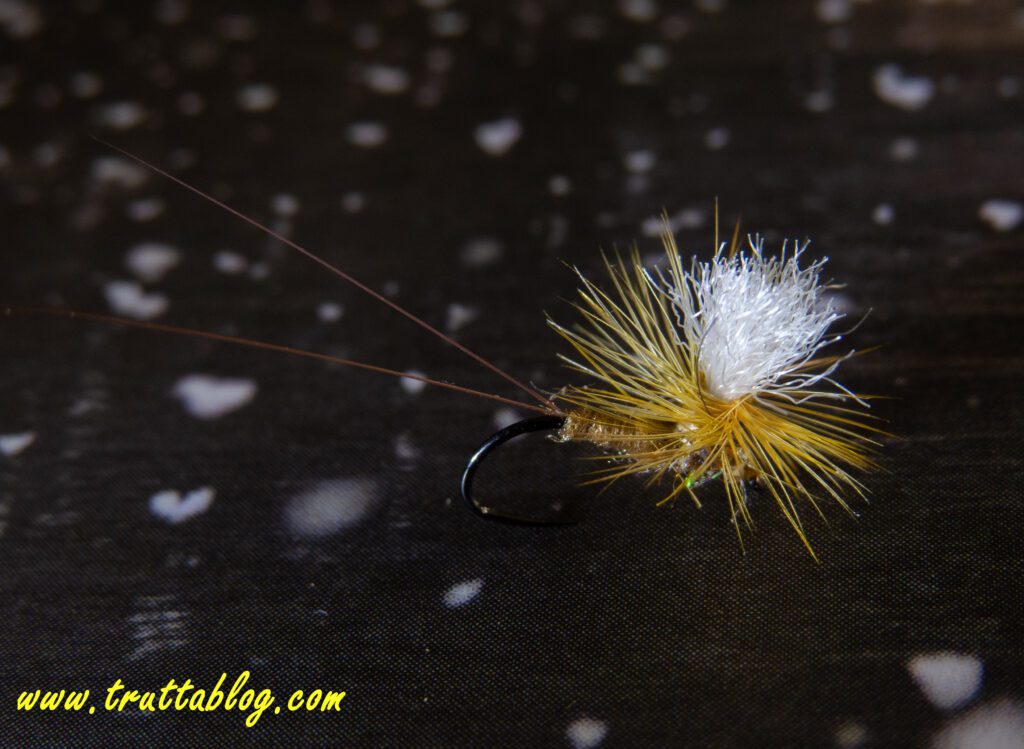
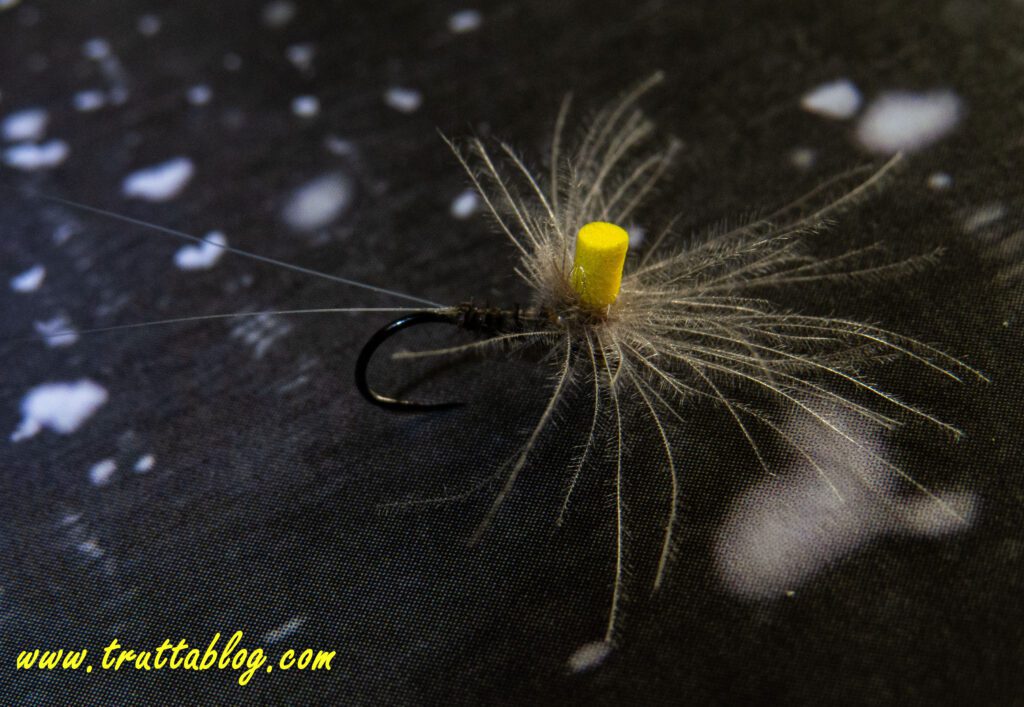
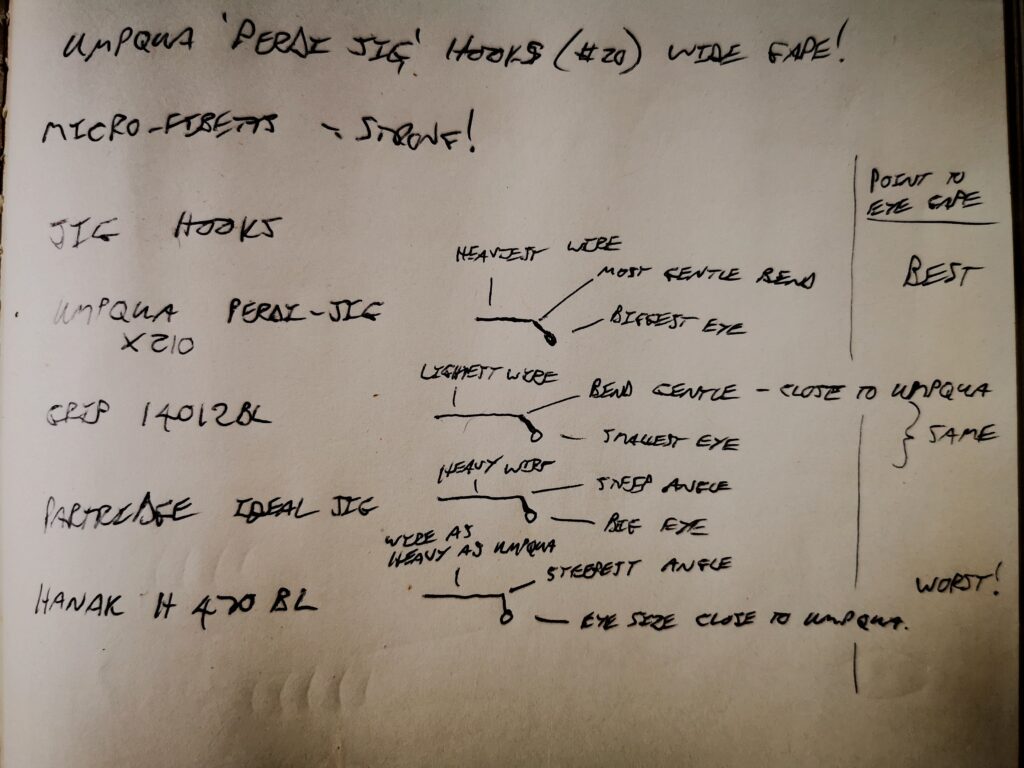
Hooks: I have become a bit fastidious in recent years, when it comes to gape width. I have boxes of small nymph hooks which I am trying to bring myself to throw away. I really should throw them out, because I am definitely not going to use them. Instead, I will use the grip Nymph and egg fly hook.
Sorry..I should have explained…I have switched from dries to nymphs now.
All those thoughts of white water, with videos of floods and waterfalls arriving on my phone, had me thinking about getting flies down deep too. So back to the Grip 12723BL. This thing takes some getting used to, because there is a lot of hook bend hanging down there, but when you start successfully hooking quite big Trout on what is otherwise a very small hook, I think you will become a convert.
When it comes to “Hanging down”….I also do the “hanging up” thing….in other words using a Jig hook to turn the nymph upside down (and supposedly reduce hook-ups on the bottom). I use all Jig hooks, but I had bought some Umpqua Perdi-Jig hooks (#18 and #20). They are interesting. Unlike my Partridge, Hanak and Grip jig hooks, the hook eye on these is aligned at 90 degrees to the shank, like a conventional fly hook.
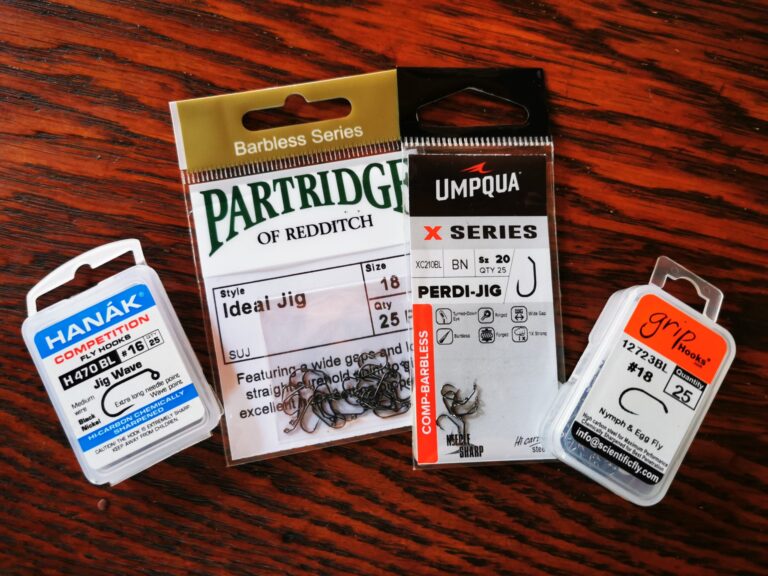
The turned-up piece ahead of the hook eye seems shorter than other jig hooks, but I think the alignment of the eye holds the bead a little further back. I know the front hole in a slotted bead is round, so it should make no difference at all. Maybe it has something to do with the fact that the “jig-angle” on these hooks is less than on all the other brands I own. So while it starts to look like the bead isn’t really going around the corner, the eye seems to be more exposed than on my small nymphs on other brand jig hooks. I will have to check that these nymphs do in fact still swim upside down with so little angling of the bead. What I do know is that the gape is great for such a small hook. I measured up a Hanak, Grip, Partridge and Umpqua, and the latter definitely has the best gape from hook point to the point of the eye.
I really like these small jog hooks for fast water….a light tippet, a small overall weight to protect the light tippet, and a highly dense fly with the minimum of “fluff” to slow its sink. It is all about density, rather than overall weight. I don’t own a bead over 2.5mm. But this is a topic all of its own.
For now I am off to tie some nymphs using no bead at all. Yes, that’s right…no bead. It seems that this is a rarity these days. I think we are a little obsessed, and I for one revel in using approach, and presentation to try get the fly down to where guys are throwing their heavy stuff. A Perdigon with no bead…..watch this space….